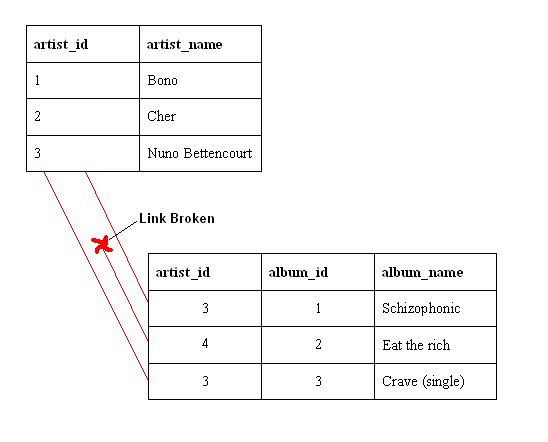
Referential integrity is a property of data stating that all its references are valid. In the context of
relational database
A relational database is a (most commonly digital) database based on the relational model of data, as proposed by E. F. Codd in 1970. A system used to maintain relational databases is a relational database management system (RDBMS). Many relatio ...
s, it requires that if a value of one attribute (column) of a
relation
Relation or relations may refer to:
General uses
*International relations, the study of interconnection of politics, economics, and law on a global level
*Interpersonal relationship, association or acquaintance between two or more people
*Public ...
(table) references a value of another attribute (either in the same or a different relation), then the referenced value must exist.
For referential integrity to hold in a relational database, any column in a base
table that is declared a
foreign key A foreign key is a set of attributes in a table that refers to the primary key of another table. The foreign key links these two tables. Another way to put it: In the context of relational databases, a foreign key is a set of attributes subject to ...
can only contain either null values or values from a parent table's
primary key
In the relational model of databases, a primary key is a ''specific choice'' of a ''minimal'' set of attributes (Column (database), columns) that uniquely specify a tuple (Row (database), row) in a Relation (database), relation (Table (database), t ...
or a
candidate key A candidate key, or simply a key, of a relational database is a minimal superkey. In other words, it is any set of columns that have a unique combination of values in each row (which makes it a superkey), with the additional constraint that removi ...
. In other words, when a foreign key value is used it must reference a valid, existing primary key in the parent table. For instance, deleting a record that contains a value referred to by a foreign key in another table would break referential integrity. Some
relational database management system
A relational database is a (most commonly digital) database based on the relational model of data, as proposed by E. F. Codd in 1970. A system used to maintain relational databases is a relational database management system (RDBMS). Many relatio ...
s (RDBMS) can enforce referential integrity, normally either by deleting the foreign key rows as well to maintain integrity, or by returning an error and not performing the delete. Which method is used may be determined by a referential integrity constraint defined in a
data dictionary.
The adjective 'referential' describes the action that a
foreign key A foreign key is a set of attributes in a table that refers to the primary key of another table. The foreign key links these two tables. Another way to put it: In the context of relational databases, a foreign key is a set of attributes subject to ...
performs, 'referring' to a linked column in another table. In simple terms, 'referential integrity' guarantees that the target 'referred' to will be found. A lack of referential integrity in a database can lead relational databases to return incomplete data, usually with no indication of an error.
Formalization
An inclusion dependency over two (possibly identical) predicates
and
from a schema is written
 Referential integrity is a property of data stating that all its references are valid. In the context of
Referential integrity is a property of data stating that all its references are valid. In the context of  Referential integrity is a property of data stating that all its references are valid. In the context of
Referential integrity is a property of data stating that all its references are valid. In the context of